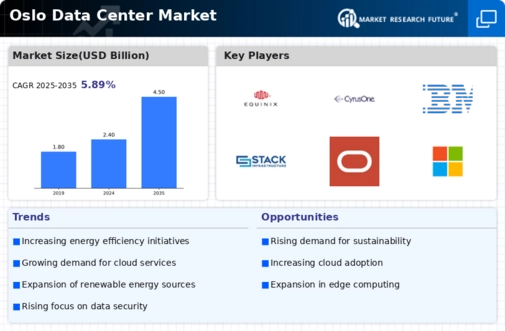Cloud Adoption Growth
The growth of cloud adoption is a significant driver in the Oslo Data Center Market. As businesses increasingly migrate to cloud-based solutions, the demand for data center services is expected to rise. This trend is fueled by the need for scalability, flexibility, and cost-effectiveness in IT infrastructure. In Oslo, the proliferation of cloud service providers is indicative of this shift, with many organizations opting for hybrid cloud models that combine on-premises and cloud resources. According to recent data, the cloud services market in Norway is projected to grow at a compound annual growth rate of over 20% in the coming years. This surge in cloud adoption not only enhances the operational capabilities of businesses but also creates opportunities for data center operators to expand their offerings and improve service delivery.
Regulatory Compliance
Regulatory compliance is a critical driver in the Oslo Data Center Market. As data protection laws become more stringent, data centers must ensure they adhere to various regulations, such as the General Data Protection Regulation (GDPR). Compliance with these regulations is essential for maintaining customer trust and avoiding hefty fines. In Oslo, the regulatory landscape is evolving, with authorities emphasizing data sovereignty and security. This has led to an increased demand for data centers that can guarantee compliance with local laws. Furthermore, organizations are increasingly prioritizing partnerships with data centers that demonstrate a commitment to regulatory adherence, as this can mitigate risks associated with data breaches. Consequently, the focus on regulatory compliance is likely to shape the operational strategies of data center operators in Oslo.
Sustainability Initiatives
The Oslo Data Center Market is increasingly influenced by sustainability initiatives. As environmental concerns gain prominence, data centers are under pressure to adopt greener practices. This includes utilizing renewable energy sources, improving energy efficiency, and implementing waste reduction strategies. In Oslo, the government has set ambitious targets for carbon neutrality, which aligns with the industry's shift towards sustainable operations. The use of hydroelectric power, which is abundant in Norway, is a key factor in reducing the carbon footprint of data centers. Furthermore, companies that prioritize sustainability may attract more clients, as businesses are increasingly seeking partners that align with their environmental values. This trend suggests that sustainability is not merely a regulatory requirement but a competitive advantage in the Oslo Data Center Market.
Technological Advancements
Technological advancements play a pivotal role in shaping the Oslo Data Center Market. Innovations in hardware and software are driving efficiency and performance improvements. The rise of artificial intelligence and machine learning is enabling data centers to optimize operations, reduce downtime, and enhance security measures. Moreover, advancements in cooling technologies are crucial for managing energy consumption, particularly in a region like Oslo, where climate conditions can impact operational efficiency. The integration of edge computing is also noteworthy, as it allows for faster data processing and reduced latency, which is essential for businesses relying on real-time data. As these technologies evolve, they are likely to redefine the competitive landscape of the Oslo Data Center Market, compelling operators to invest in cutting-edge solutions.
Increased Demand for Data Storage
The increased demand for data storage is a prominent driver in the Oslo Data Center Market. As the volume of data generated by businesses continues to surge, the need for robust storage solutions becomes paramount. This trend is particularly evident in sectors such as finance, healthcare, and e-commerce, where data management is critical. In Oslo, the rise of big data analytics and the Internet of Things (IoT) is further fueling this demand, as organizations seek to harness insights from vast amounts of data. Recent statistics indicate that the data storage market in Norway is expected to grow significantly, with projections suggesting a doubling of storage capacity requirements in the next five years. This escalating demand presents opportunities for data center operators to enhance their infrastructure and service offerings, positioning themselves as key players in the evolving landscape of the Oslo Data Center Market.


















Leave a Comment